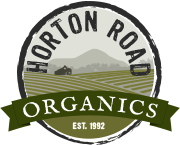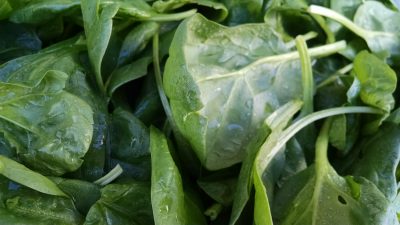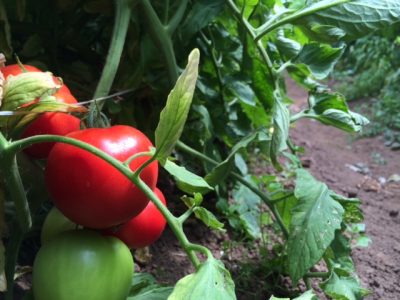What’s in Box #16?
Rainbow Chard: Bright Lights variety. As the temps cool down, our greens become more beautiful and sweeter. Chard is a pretty good keeper and you can use the stems too. . . they just take longer to cook.
Tomatoes: Early Girl variety. A low-acid slicer. These are dry-farmed in one of our greenhouses which makes the flavor more intense.
Spinach: Spinach is a cooler weather staple for us. Cold and even frosty nights will make these leaves sweeter. Don’t be fooled by the size of the bag, the greens will shrink down quite a bit when you cook them.

Potatoes: Carola variety. A good all-purpose potato. Can be used in soups, salads and are also good roasted. These have thicker skins now, so no need to refrigerate. Just keep them somewhere dark, dry and cooler for best storage.
Broccolini: One of our treats for this time of year. If you find regular broccoli stems to be too tough, then broccolini will work well for you. The entire stalk is tender, so make sure to use the whole thing in your cooking. Great in a stir-fry or sauteed in some soy sauce or tamari.
Cilantro: Marino variety. This crop is doing well right now. Not a great keeper, so plan to use fairly quickly. Cilantro pesto is an excellent way to store this for the winter.
Sweet Onions: Candy variety. We have now harvested all of our onions from the field. These do not need to be kept in the fridge, but they are also not long-term keepers. You can keep them on your counter and just use them within a month or so. 
Gypsy Peppers: The first of the season! These are a very sweet, heirloom pepper. They are sweetest when they are dark red but can be eaten at any color. The orange ones taste great too, but they will continue to ripen, so no need to eat them right away.
Recipes:
Spinach and White Bean Soup
https://www.delish.com/cooking/recipe-ideas/recipes/a47292/spinach-and-white-bean-soup-recipe/
For those chilly nights of late summer/early fall, warm up with this cozy and hearty soup. This calls for in-season carrots, zucchini, and peas, so you can truly get a full taste of Oregon’s harvest. We make a lot of soups in the apprentice barn here as they are simple to make and can provide for an entire week – we will surely be having this! ~ Derek
♦ ♦ ♦ ♦ ♦ ♦ ♦
Broccolini Almond Pizza
I love pizza and brocolini so what’s better than combing the two? I love the idea of a good ‘ol pizza with the addition of a delicious summer vegetable to start my weekends off right. So open a bottle of wine pour yourself a glass, or crack open a beer and enjoy! ~ Heather
Ingredients:
– Any pizza dough you so desire
– 2/3 cups marinara sauce
– 2 cups low moisture mozzarella cheese
– ½ cup crumbled feta
– ½ lb. broccolini
– ¼ cup sliced almonds
– 1 tsp. Olive oil
Preheat your oven to 500 degrees. To prep the broccolini for the pizza, cut off the tough bottoms, boil in hot water for about a minute, pat dry then toss in a small amount of olive oil. Cut any large pieces in half. Cover the dough with the sauce, sprinkle on the mozzarella and feta cheese then add the broccolini. Garnish with the almond slices and any other pizza toppings such as fresh basil or red pepper flakes. Bake for about 12 minutes or until the crust is golden and the cheese has slightly browned.
cookieandkate.com/2017/broccolini-almond-pizza-recipe/
♦ ♦ ♦ ♦ ♦ ♦ ♦
Veggie Samosas with Diced Potatoes
https://www.hotforfoodblog.com/recipes/2010/09/26/vegan-samosas?rq=samosas
These Veggie Samosas are made from scratch so you know they are going to be delicious. If you’re in a time crunch, make the dough ahead of time, cover, and refrigerate for up to 24 hours! ~ Taylor

 Photo taken by Kristin during her visit
Photo taken by Kristin during her visit
